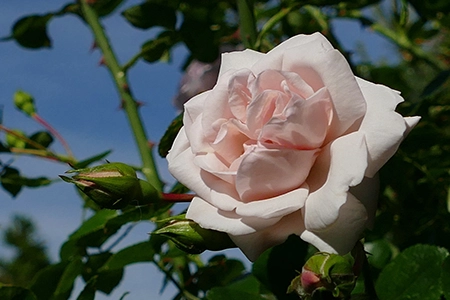Introduction
As February unfolds, rose enthusiasts engage in the transformative art of pruning, shaping the health and beauty of these beloved blooms. However, those who often own roses find themselves asking questions about how to prune roses. This guide explores the profound significance of this practice, timed during dormancy for a rejuvenated burst in spring.
Diverse rose varieties demand tailored pruning approaches. Climbing roses require strategic cuts for a sturdy framework, while hybrid teas benefit from more aggressive pruning to stimulate prolific flowering. Shrub roses call for a gentler touch, emphasising a balanced structure.
Fellow gardeners, let’s embrace the artistry of rose pruning in February—a prelude to the grand symphony of blooms that awaits. Together, we navigate the intricacies, of sculpting our rose gardens into breathtaking canvases of colour, fragrance, and vitality.
The Importance of Pruning Roses
Pruning roses transcend the realm of mere aesthetics; it stands as a horticultural imperative that profoundly influences the health and vitality of your cherished blooms. When undertaken at the opportune moment, such as in the crisp embrace of February, this practice becomes a transformative act, wielding the power to rejuvenate and invigorate the rose bushes.
At its core, pruning serves as a meticulous sculptor, chiselling away dead or diseased wood to reveal the essence of the plant. By doing so, it paves the way for new growth, an essential mechanism that breathes life into the roses, fostering a cycle of renewal and vigour. The strategic shaping of the plant, particularly during its dormant phase, ensures optimal sunlight exposure, a critical factor that influences the quality of blooms and the overall structure of the rose.
Owners of roses must learn how to prune roses. Beyond the artistic dimensions of pruning lies a practical and health-oriented purpose. By carefully removing excess foliage and branches, pruning enhances air circulation within the rose bush. This reduction in humidity, coupled with improved airflow, acts as a natural deterrent against common rose ailments such as powdery mildew and black spot. In essence, pruning becomes a shield, fortifying the roses against potential diseases that may compromise their well-being.
Moreover, the act of pruning is an orchestrator of floral abundance. By stimulating the development of more robust blooms, it transforms the rose bush into a prolific source of beauty. This deliberate intervention does not merely cater to the visual senses; it fortifies the very structure of the rose, instilling resilience and strength that manifests in the quality and longevity of each bloom.
In essence, pruning roses in February is a harmonious blend of art and science. It is a testament to the gardener’s understanding of the delicate balance required to nurture a garden that thrives in both form and function. So, as you step into the garden with pruning shears in hand, remember that you are not merely trimming branches; you are sculpting the vitality and beauty of your roses, ensuring they flourish and grace your garden with an abundance of exquisite blooms.
Different Roses and their Pruning Needs
Delving into the diverse world of roses unveils a nuanced landscape where not all varieties follow the same pruning rules. Climbing roses, with their tendency to ascend to greater heights, thrive with light pruning after their initial flush of blooms in early summer. Hybrid teas, celebrated for their exquisite individual blooms, often demand more frequent pruning throughout the growing season to stimulate continuous flowering.
Shrub roses, known for their diverse habits, can be lightly pruned in late winter or early spring, emphasising a balanced and open structure. This bespoke approach ensures that each type of rose reaches its full potential, enhancing both its structural integrity and the abundance of blooms it offers.
10 Roses for the UK Garden and February Pruning
Hybrid Tea Rose (Rosa ‘Peace’)
Failing to prune this iconic rose in February may compromise its flowering potential, leading to reduced bloom abundance. Without the rejuvenating effect of timely pruning, Hybrid Tea Roses like ‘Peace’ become more susceptible to diseases such as black spot, impacting their overall health and visual appeal.
Floribunda Rose (Rosa ‘Iceberg’)
The compact form and prolific flowering of Floribunda Roses like ‘Iceberg’ rely on proper February pruning. Without this, the shrub may lose its desired shape, leading to reduced flowering and an overall less vibrant appearance.
English Rose (Rosa ‘Gertrude Jekyll’)
English Roses, celebrated for their lush blooms, require February pruning to prevent leggy growth and maintain a balanced form. Without this intervention, ‘Gertrude Jekyll’ and similar varieties may become prone to diseases, affecting their vigour and longevity.
Miniature Rose (Rosa ‘Starina’)
Insufficient pruning in February can compromise the vigour and compact habit of Miniature Roses such as ‘Starina.’ Timely pruning ensures a more robust and visually appealing display throughout the growing season.
Groundcover Rose (Rosa ‘Pink Drift’)
Groundcover Roses like ‘Pink Drift’ benefit from timely February pruning to prevent overly dense growth. Without this intervention and knowledge on how to prune roses, these roses may hinder air circulation, increasing the risk of diseases and diminishing their overall visual impact.
Bourbon Rose (Rosa ‘Louise Odier’)
Proper February pruning is essential for maintaining the vigour and graceful form of Bourbon Roses like ‘Louise Odier.’ Neglecting this task may result in a less appealing appearance and reduced overall vitality.
Damask Rose (Rosa ‘Madame Hardy’)
Failure to prune Damask Roses in February can lead to tangled growth patterns and decreased flowering. Timely intervention ensures a more structured form and encourages a prolific display of blooms.
Patio Rose (Rosa ‘Sweet Dream’)
Without proper February pruning, Patio Roses like ‘Sweet Dream’ may develop leggy growth and produce fewer flowers. Pruning is essential for maintaining a compact habit and ensuring a vibrant, eye-catching presence in your garden.
Climbing Rose (Rosa ‘Golden Showers’)
February pruning plays a crucial role in maintaining the grace and abundance of climbing roses like ‘Golden Showers.’ Without this essential intervention, climbing roses may succumb to tangled growth, diminishing their structural integrity and resulting in fewer spectacular blooms.
Shrub Rose (Rosa ‘Graham Thomas’)
Neglecting February pruning for Shrub Roses like ‘Graham Thomas’ can result in overcrowded growth, hindering air circulation and light penetration. This, in turn, diminishes flower production and compromises the overall health of the shrub.
How to Prune Roses
While pruning roses may initially seem like a formidable task it is important to learn how to prune roses properly so that they can blossom in your garden. Armed with the right knowledge and approach, it transforms into a rewarding endeavour that significantly boosts the health and beauty of your roses. Here’s a detailed, step-by-step guide to assist you in navigating the process of pruning roses in February:
Gather your Tools
Before embarking on the pruning journey, ensure you have the necessary tools – a pair of sharp pruning shears, sturdy gloves to shield your hands from thorns, and, if needed, long-handled loppers for tackling larger canes.
Identify Dead or Diseased Wood
Thoroughly inspect the rose bush for any signs of dead, diseased, or damaged wood. Trim these canes back to healthy tissue, executing clean, angled cuts just above a robust bud or cane. Eliminating these sections not only prevents the spread of diseases but also encourages the emergence of new, healthy growth.
Remove Weak or Crossing Canes
Identify and eliminate weak, spindly, or crossing canes. Strive for an open, vase-like structure that facilitates air and sunlight penetration into the bush’s centre. Crossing canes rubbing against each other can create entry points for diseases, making their removal crucial.
Shape the Bush
Consider the natural shape of the rose bush and aim for an open, balanced form. Prune to outward-facing buds to stimulate the growth of canes away from the centre, fostering optimal air circulation and minimising disease risks.
Reduce Height if Necessary
If your rose bush has grown excessively tall, reduce its height by cutting back some of the main canes. Make these cuts just above an outward-facing bud to encourage new growth in a desirable direction.
Prune Hybrid Teas and Floribundas more Aggressively
Hybrid tea and floribunda roses benefit from a more aggressive pruning approach. Cut these varieties back to about 8–12 inches above ground level to stimulate robust new growth and ensure prolific flowering.
Lightly Prune Shrub Roses
Shrub roses generally require lighter pruning. Remove dead or weak wood, shape the bush, and encourage an open structure, as shrub roses often boast a more natural and sprawling form.
Climbing Roses
For climbing roses, remove dead or weak wood and cut back lateral canes to promote branching. Aim for a framework of sturdy, well-spaced canes to support the climbing habit.
Seal Pruned Cuts
After each cut, apply a small amount of pruning sealant or white glue to the exposed cane ends. This aids in disease prevention and facilitates quicker healing.
Collect and Dispose of Debris
When wondering how to prune roses it is important to consider the clean up afterwards. To conclude the pruning process by cleaning up the area around the rose bush. Collect and dispose of pruned canes and leaves to minimise the risk of diseases lingering in the garden.
By following these steps, you’ll be well on your way to mastering the art of pruning roses. Remember, each rose variety may have its own specific needs, so always consider the characteristics of your particular roses when pruning. With practice, you’ll become more confident in shaping your roses for a blooming spring. For more information on pruning roses in winter visit our detailed blog on this subject!
NGS Rose Care Expertise
At NGS, we take pride in being your dedicated partner in cultivating healthy and vibrant roses. Our team of seasoned horticultural experts specialises in comprehensive rose care services, offering tailored guidance on the best pruning practices to ensure your roses not only survive but thrive. We recognise and understand the unique needs of various rose varieties, providing expert assistance in navigating the intricacies of their growth patterns and ensuring they receive the care they deserve.
Whether you have hybrid teas demanding a more aggressive approach, climbing roses requiring careful support and shaping, or shrub roses boasting a natural and sprawling form, our expertise spans across all facets of rose care. We emphasise timely pruning as a crucial element, aligning with the natural rhythms of your roses’ growth cycles to pave the way for a stunning spring display.
Trust in NGS’s wealth of knowledge and experience to be your go-to partner for rose care. From the initial consultation to the meticulous execution of pruning techniques, we are committed to enhancing the health, structure, and overall vitality of your roses and hope to answer all of your questions around the subject of how to prune roses. Choose NGS for a rose care experience that goes beyond routine maintenance, ensuring your roses become a focal point of beauty in your outdoor space.
Head to our Contact Us page to get in touch with one of our team members if you would like more advice on how you can fit roses into your garden vision and whether they are a suitable choice for your lifestyle in terms of their pruning requirements.
Conclusion
As you step into the garden with secateurs in hand this February, it’s more than just a routine task – it’s a unique opportunity to sculpt the destiny of your roses for the coming spring. Pruning roses is akin to a rhythmic dance with nature, a carefully choreographed routine that, when executed with care and knowledge, yields a symphony of vibrant colours and fragrant blooms.
With NGS by your side, this intricate dance becomes a harmonious collaboration between your vision for your garden and our expertise in rose care. We understand that pruning is not merely about shaping the physical form of your roses but about nurturing their potential for a flourishing and picturesque display. Our team of experts stands ready to guide you through the delicate steps of this seasonal dance, ensuring that your roses not only survive but thrive in the ever-changing seasons of your garden.
So, as you embark on this pruning journey, consider it a partnership with nature, where each cut contributes to the story of growth and renewal. With NGS as your trusted companion, your roses are in expert hands, and the result will be a garden that bursts forth with vitality and beauty come spring. Happy pruning!













